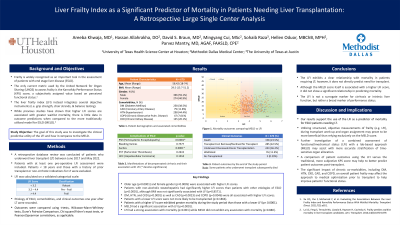Tuesday Poster Session
Category: Liver
P3794 - Liver Frailty Index is a Significant Predictor of Mortality in Patients Needing Liver Transplantation: A Retrospective Large Single Center Analysis
Tuesday, October 24, 2023
10:30 AM - 4:00 PM PT
Location: Exhibit Hall

Has Audio

Areeba Khwaja, MD
University of Texas Health Science Center at Houston
Houston, Texas
Presenting Author(s)
Award: Presidential Poster Award
Areeba Khwaja, MD1, Hassan Allahrakha, DO2, David S. Braun, MD3, Mingyang Cui, MSc4, Sohaib Raza, 4, Hellen Oduor, MBChB, MPH4, Parvez Mantry, MD4
1University of Texas Health Science Center at Houston, Houston, TX; 2Methodist Dallas, Dallas, TX; 3Methodist Dallas Medical Center, Dallas, TX; 4Methodist Liver Institute, Dallas, TX
Introduction: Frailty is widely recognized as an important tool in the assessment of patients with end stage liver disease (ESLD). The only current metric used by the United Network for Organ Sharing to assess frailty is the Karnofsky Performance Status (KPS) score, a subjectively assigned value based on perceived functional status. The liver frailty index (LFI) instead integrates several objective instruments (i.e. grip strength, chair strands, and balance testing). While previous studies have shown that higher LFI scores are associated with greater waitlist mortality, there is little data in outcome predictions when compared to the more traditionally utilized model for ESLD (MELD). This study aims to investigate the clinical predictive utility of the LFI and how it compares to the MELD.
Methods: A retrospective database review was conducted of patients who underwent liver transplant (LT) between June 2017 and May 2022. Patients with at least one preoperative LFI assessment were included. Patients < 18 years and those with a history of prior transplant or non-cirrhotic indications for LT were excluded. LFI was calculated on a validated categorical scale (< 3.2=robust; 3.2-4.4=pre-frail; >4.4=frail). Etiology of ESLD, comorbidities, and clinical outcomes one year after LT were recorded. Outcomes were compared using t-tests, Wilcoxon-Mann-Whitney tests, Dunn’s Pairwise Comparison, Chi square/Fisher’s exact tests, or Pearson/Spearman correlations as applicable.
Results: A total of 670 patients were included in this study (mean age: 58.4; female: 40.9%). Older age (p< 0.0001) and female gender (p=0.0005) were associated with higher LFI scores. Patients with non-alcoholic steatohepatitis had significantly higher LFI than patients with other etiologies of ESLD. Patients with a higher LFI exhibited greater mortality during the study period than those with a lower LFI (p< 0.0001). MELD had a significant association with LFI (p=0.0001). LFI had a strong association with mortality (p< 0.001) while MELD did not exhibit any association with mortality (p=0.880).
Discussion: LFI is a strong predictor of mortality for ESLD patients needing LT. Utilizing structured, objective measurements of frailty (e.g. LFI), during transplant work-up and organ assignment may prove to be more beneficial than relying exclusively on the MELD. Further investigation of a combined assessment of functional/mechanical status (LFI) with a lab-based approach (MELD) as well as a comparison of patient outcomes using LFI versus KPS is needed.
Disclosures:
Areeba Khwaja, MD1, Hassan Allahrakha, DO2, David S. Braun, MD3, Mingyang Cui, MSc4, Sohaib Raza, 4, Hellen Oduor, MBChB, MPH4, Parvez Mantry, MD4. P3794 - Liver Frailty Index is a Significant Predictor of Mortality in Patients Needing Liver Transplantation: A Retrospective Large Single Center Analysis, ACG 2023 Annual Scientific Meeting Abstracts. Vancouver, BC, Canada: American College of Gastroenterology.
Areeba Khwaja, MD1, Hassan Allahrakha, DO2, David S. Braun, MD3, Mingyang Cui, MSc4, Sohaib Raza, 4, Hellen Oduor, MBChB, MPH4, Parvez Mantry, MD4
1University of Texas Health Science Center at Houston, Houston, TX; 2Methodist Dallas, Dallas, TX; 3Methodist Dallas Medical Center, Dallas, TX; 4Methodist Liver Institute, Dallas, TX
Introduction: Frailty is widely recognized as an important tool in the assessment of patients with end stage liver disease (ESLD). The only current metric used by the United Network for Organ Sharing to assess frailty is the Karnofsky Performance Status (KPS) score, a subjectively assigned value based on perceived functional status. The liver frailty index (LFI) instead integrates several objective instruments (i.e. grip strength, chair strands, and balance testing). While previous studies have shown that higher LFI scores are associated with greater waitlist mortality, there is little data in outcome predictions when compared to the more traditionally utilized model for ESLD (MELD). This study aims to investigate the clinical predictive utility of the LFI and how it compares to the MELD.
Methods: A retrospective database review was conducted of patients who underwent liver transplant (LT) between June 2017 and May 2022. Patients with at least one preoperative LFI assessment were included. Patients < 18 years and those with a history of prior transplant or non-cirrhotic indications for LT were excluded. LFI was calculated on a validated categorical scale (< 3.2=robust; 3.2-4.4=pre-frail; >4.4=frail). Etiology of ESLD, comorbidities, and clinical outcomes one year after LT were recorded. Outcomes were compared using t-tests, Wilcoxon-Mann-Whitney tests, Dunn’s Pairwise Comparison, Chi square/Fisher’s exact tests, or Pearson/Spearman correlations as applicable.
Results: A total of 670 patients were included in this study (mean age: 58.4; female: 40.9%). Older age (p< 0.0001) and female gender (p=0.0005) were associated with higher LFI scores. Patients with non-alcoholic steatohepatitis had significantly higher LFI than patients with other etiologies of ESLD. Patients with a higher LFI exhibited greater mortality during the study period than those with a lower LFI (p< 0.0001). MELD had a significant association with LFI (p=0.0001). LFI had a strong association with mortality (p< 0.001) while MELD did not exhibit any association with mortality (p=0.880).
Discussion: LFI is a strong predictor of mortality for ESLD patients needing LT. Utilizing structured, objective measurements of frailty (e.g. LFI), during transplant work-up and organ assignment may prove to be more beneficial than relying exclusively on the MELD. Further investigation of a combined assessment of functional/mechanical status (LFI) with a lab-based approach (MELD) as well as a comparison of patient outcomes using LFI versus KPS is needed.
Disclosures:
Areeba Khwaja indicated no relevant financial relationships.
Hassan Allahrakha indicated no relevant financial relationships.
David Braun indicated no relevant financial relationships.
Mingyang Cui indicated no relevant financial relationships.
Sohaib Raza indicated no relevant financial relationships.
Hellen Oduor indicated no relevant financial relationships.
Parvez Mantry indicated no relevant financial relationships.
Areeba Khwaja, MD1, Hassan Allahrakha, DO2, David S. Braun, MD3, Mingyang Cui, MSc4, Sohaib Raza, 4, Hellen Oduor, MBChB, MPH4, Parvez Mantry, MD4. P3794 - Liver Frailty Index is a Significant Predictor of Mortality in Patients Needing Liver Transplantation: A Retrospective Large Single Center Analysis, ACG 2023 Annual Scientific Meeting Abstracts. Vancouver, BC, Canada: American College of Gastroenterology.

